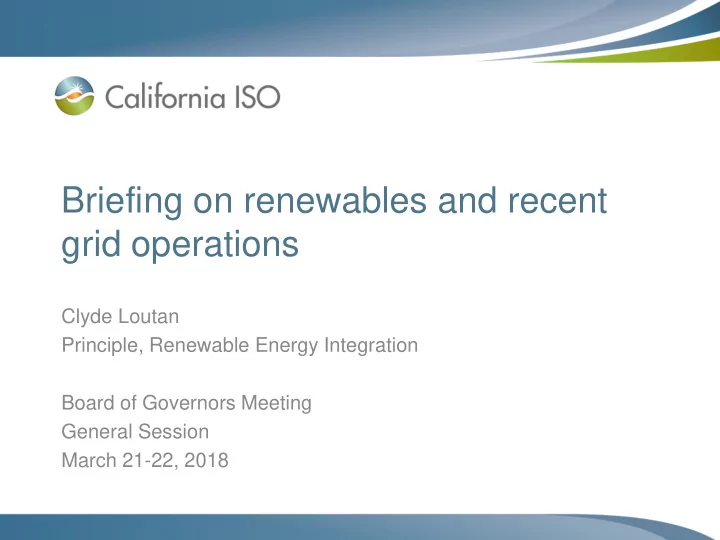

Briefing on renewables and recent grid operations Clyde Loutan Principle, Renewable Energy Integration Board of Governors Meeting General Session March 21-22, 2018 Page 1
Sample of operationally notable days with high renewable production September 1, 2017: Peak demand of 50,116 MW February 18, 2018: Minimum net load 7,149 MW March 4, 2018: Maximum 3-hour upward ramp 14,777 MW Maximum 1-hour upward ramp 7,545 MW March 5, 2018: Maximum solar production 10,409 MW Page 2
Maximum percentage of 1-minute load served by wind/solar, total RPS and non-carbon resources Comparison of Load Served by Different Combinations of Resources 90.0 79.9 80.0 75.0 70.6 67.2 70.0 64.8 60.9 58.8 57.4 60.0 Percent (%) 50.1 50.0 44.4 40.0 30.2 30.0 24.7 20.0 10.0 0.0 9/1/2017 2/18/2018 3/4/2018 3/5/2018 Load served by Wind/Solar (%) Load Served by RPS (%) Load served by Non-Carbon Res. (%) Page 3
Percentage of daily load served by wind/solar, total RPS and non-carbon resources 60.0 48.5 50.0 40.6 40.0 38.0 Percent (%) 34.7 31.2 30.5 29.1 30.0 26.2 23.1 18.9 20.0 15.7 10.2 10.0 0.0 9/1/2017 2/18/2018 3/4/2018 3/5/2018 Load served by Wind/Solar (%) Load Served by RPS (%) Load served by Non-Carbon Res. (%) Page 4
ISO GHG emissions reduced by 23% since 2014 Page 5
In 2017, the ISO peak load was 50,116 MW and occurred at 15:58:24 on Friday, September 1 Max net-load of 47,168 MW served by: Imports: 24% Hydro: 11% Thermal: 56% Other: 9% • High temperatures along the coast • Peak Load: 50,116 MW • Peak net-load: 47,168 MW • Peak load decreased by 2,948 MW • Solar production decreased by 7,199 MW • Net Load increased by 5,301 MW • Essentially no wind Page 6
Actual net-load and 3-hour ramps are about four years ahead of the ISO’s original estimate primarily due to under forecasting roof-top solar PV installation Typical Spring Day Steeper Ramps Actual 3-hour ramp of 14,777 MW on Deeper March 4, 2018 Belly Net Load of 7,149 MW on February 18, 2018 Page 7
On Sunday, February 18, 2018, the ISO experienced a minimum net-load of 7,149 MW @ 14:06 3-hr, 13,597 MW ramp met by: - Import ~ 62% - Hydro – 10% - Thermal – 28% • Max renewables curtailed 1,905 MW • Total curtailment was 9,070 MWh • Max EIM Export was 2,338 MW • Diablo Unit 2 was off-line • One of the biggest challenges during low minimum net- load is the capability to commit internal resources to meet the evening ramp and other AS requirements • Rely on imports on low net-load days to meet ramps Page 8
On Sunday, March 4, 2018 the maximum 3-hour upward ramp was 14,777 MW 3-hr, 14,777MW ramp met by: - Import ~ 36% - Hydro – 15% - Thermal – 49% • The ISO markets economically optimized resources both internally and externally to meet demand • Imports may or may not be available when needed to meet evening ramps • Internal resources makes up about 64% of ramp • Cannot rely on wind to meet ramps Page 9
The 1-Hour upward ramps are more than 50% of the three hour ramps, which indicates the need for faster ramping resources 56% of gross peak demand 48% of gross peak demand 53% of gross peak demand Page 10
Increasing trend of renewable curtailment varies with seasonal and hydro conditions 2017 Curtailment Percentage of Potential Production Solar: 2.8% Wind: 1.3% Page 11
Summary/Observations • Load reliably served by renewable resources continue to grow • GHG associated with serving the ISO load has decreased 23% over the last four years • Minimum net load continues to drop lowers than expected • Curtailment of renewable resources although low relative to total production is increasing rapidly • Ramps are increasing and present a risk going forward if sufficient ramping capability does not exist • During spring our reliance on imports and internal gas resources to meet the ramps is significant and creates opportunities for solutions – The ISO relies heavily on imports to meet its ramps during days with low loads and high renewable production – During the spring months, at higher net-load levels the ISO relies on internal resources to meet its ramps Page 12
Recommend
More recommend